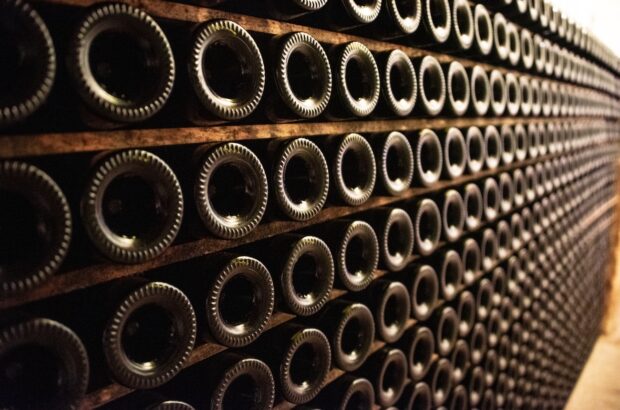The Aszú wines of the Tokaj region are steeped in history and tradition, being the first noble rot-affected wines in history of which we are aware. The habit has generally been for these wonderful wines to be reserved to go with desserts and, as such, they usually find their way to our table only at the end of the dinner.
But to consign Tokaji Aszú only to the pudding course is missing out on so much potential drinking pleasure. These wines possess a fine balance of aromatics, acidity, flavour intensity, sweetness and dry extract, providing a fulfilling mouthfeel. I would urge readers to explore different ways to taste and match Aszú, along with other sweet styles from Tokaj. And we hope this guide will encourage you to do just that, experimenting with food pairing in what could be considered ‘unconventional’ ways.
Great wines, great pairings
A year ago, Wines of Hungary UK set out to demonstrate just how versatile sweet Tokaji can be, at a special wine and food- matching lunch at Michelin one-star Trivet restaurant in London. The aim was to challenge the accepted criteria – the ‘norm’ in food and wine matching – and to A perfect match – Sommeliers pair Tokaj’s sweet wines with savoury courses of these wines with savoury dishes. As it turned out, the younger Aszús were excellent with lighter dishes, while the wines with more bottle age complemented richer dishes such as game; they also worked wonders with cured meats and cheese. Ultimately, great wines tend to work very well with a wide variety of dishes.
In the pages that follow, 10 of the UK’s leading sommeliers and restaurant specialists share their specific insights into pairing Aszú wines with food (some of the wines may only be found on the restaurant’s wine list). But here we start with a few general tips for matching Aszú with food, based on my own experience.
Firstly, foods high in fat, salt, sugar and acidity, as well as ingredients such as saffron, all complement the sweetness and mineral structure of these wines. Also, consider matching the weight and body of the wine to that of the dish. Include elements that are in contrast to, or resemble the properties of the wine, such as salt to pair with sweetness, paprika and saffron-like spices for similar flavours. Charring or caramelisation goes well with the sweetness and minerality of the wine. Punchy, strong flavours are always good, as long as they are matched with similarly punchy, fuller styles of wine.
Contrasting structures and textures are difficult to match, though when they work they can create truly memorable pairing experiences. For instance, a light wine can work with a bold and rich dish. Equally, spiced pigeon can benefit from pairing with a richly complex aged Aszú.
Enjoy the journey here through different styles of cuisine. Our 10 experts have taken the time to play with the acidity, sweetness, mineral content and body of 10 Tokaji sweet wines (Aszú and Szamorodni), to create dishes that provide a perfect match. Why not read through the results of their endeavours with a glass of Aszú in hand? Then put on your apron, ready to recreate some of them for yourself. Egészségedre!

Head sommelier at Ekstedt, Klearhos Kanellakis matches Royal Tokaji, Aszú Blue Label 5 Puttonyos 2017 with juniper-smoked wild duck
Klearhos Kanellakis
Head sommelier, Ekstedt at the Yard, London SW1A
WINE Royal Tokaji, Aszú Blue Label 5 Puttonyos 2017 (£29.50-£33.95/50cl Jeroboams, Majestic, The Wine Society)
DISH Juniper-smoked wild duck
Royal Tokaji was founded in 1990 by a consortium that included world-renowned author and Decanter columnist Hugh Johnson. Its aim was to bring Tokaji wines back to international attention and it soon became one of the most respected producers in the region ‘We’re very familiar with their wines,’ says Kanellakis. ‘We sell several of their cuvées in our restaurant, and we even serve Eszencia in teaspoons (see All about Aszú) at special times of the year, such as Christmas and Valentine’s Day.
The Blue Label 5 Puttonyos is usually served at Ekstedt with a dessert of smoked apple tart with a glaze made from fermented raspberries. Kanellakis feels that the sweet-sour combination of apples and tangy berries marries perfectly with the wine’s kick of acidity.
To ring the changes, Kanellakis worked with head chef Therese Andersson (who competed in the BBC’s 2022 MasterChef: The Professionals) to match the wine with a savoury dish of juniper-smoked duck. ‘The smokiness of the duck is well balanced by the sweet fruitiness of the wine,’ he explains, ‘and there’s a beetroot purée in the dish that has a sweetness that makes it difficult to pair with dry red wines, but which works beautifully with the sweetness of the Tokaji.’ Kanellakis has been so impressed with the results that the pairing is due to become a regular feature of his autumn menu.

Wine director at Iconic Luxury Hotels group (includes Cliveden House in Berkshire, Chewton Glen in Hampshire), Francesco Gabriele matches Szepsy, Aszú 6 Puttonyos 2017 with Chewton Glen twice-baked cheese soufflé with frisée salad, walnuts and apples
Francesco Gabriele
Wine director, Iconic Luxury Hotels group (includes Cliveden House in Berkshire, Chewton Glen in Hampshire)
WINE Szepsy, Aszú 6 Puttonyos 2017 (£164.95-£190/50cl 9 Elms Wines, AG Wines, Hedonism)
DISHES Chewton Glen twice-baked cheese soufflé with frisée salad, walnuts and apples; Roast gilthead bream with Orkney scallops and salad niçoise.
The long-established Szepsy family’s wines have arguably reached their apogee under the guidance of the current generations of István senior and István junior. Gabriele is a huge fan of their ‘beautiful’ wines. He commends the Aszú, in particular, for its versatility, and paired the 2017 Aszú with two dishes.
The first is one of Chewton Glen’s signatures: a twice-baked cheese soufflé with an accompanying salad that features a combination of bitter, tart and sweet flavours. ‘The combination makes me think of that classic pairing of cheese and chutney,’ says Gabriele, ‘as the wine gives you that sweet-sour fruitiness you’d get from the pickle.’ The bitterness of the frisée leaves and the walnuts provide a welcome counterpoint to the sweetness of the wine, he feels, helping to balance the pairing and prevent it from becoming overwhelmingly rich.
The second pairing, which partners the wine with bream, works slightly differently. ‘The fish is fairly oily,’ explains Gabriele, ‘and the acidity of the wine helps to cut through its richness. ‘Further,’ he continues, ‘the outstanding component of this dish is that it contains caramelised black pepper, and the apricot fruit and sweetness of the wine harmonises beautifully with this spicy element.’

Wine & beverage director at Ynyshir, Rory Eaton matches Balassa, Szamorodni 2021 with Duck liver mousse with Bramley apple, puffed spelt and spelt tuile, smoked eel
Rory Eaton
Wine & beverage director, Ynyshir, Mid Wales (Michelin 2*)
WINE Balassa, Szamorodni 2021 (balassabor.hu)
DISH Duck liver mousse with Bramley apple, puffed spelt and spelt tuile, smoked eel
István Balassa is a relative newcomer to Tokaj, having founded his eponymous winery in 2005 with the aim of creating wines that reveal the intricate details of the region’s terroir.
‘What I really like about Balassa’s wines,’ says Eaton, ‘is that they have balance and freshness, while retaining complexity and sweetness. As a result, I find them really versatile when it comes to pairing them with food.’ Eaton has matched the wine to a complex dish that contains elements that are sweet and sour, but which also plays with texture and temperature. ‘The dish offers a take on the classic pairing of Tokaji and duck liver,’ explains Eaton, ‘but the duck mousse is served cold – it’s halfway between an ice cream and a parfait in terms of texture – and the lighter Szamorodni works well with the temperature of this dish.
‘The apple adds both sweetness and acidity to the dish – elements echoed in the wine – while the puffed spelt, with its toasted character, creates another layer that is almost like the seasoning you get from oak ageing,’ he continues, ‘and this too plays well with the flavours in the wine. ‘Finally,’ he adds, ‘there’s a dusting of smoked eel grated over the dish. A big element of our cooking here is done over fire, and the sweetness of the Tokaji wine harmonises really well with the smoky oak flavours of the fish.’

Sommelier at The Olive Tree Restaurant, Aisling Bury matches Füleky, Aszú 6 Puttonyos 2007 with pineapple cooked over coal, tonka bean parfait, fennel and ‘extra-old’ balsamic vinegar
Aisling Bury
Sommelier, The Olive Tree Restaurant, Bath (Michelin 1*)
WINE Füleky, Aszú 6 Puttonyos 2007 (£71/50cl Amathus Drinks)
DISH Pineapple cooked over coal, tonka bean parfait, fennel and ‘extra-old’ balsamic vinegar.
Getting the right marriage between dish and wine often takes a lot of trial and error, with various elements needing to be adjusted to ensure that the final result is truly harmonious. But, says Bury, in this instance, wine and food hit it off from the start.
‘This pineapple dish is the last on a nine-course menu,’ she says, ‘so I was looking for something that had that “wow” factor, without being cloying or heavy. ‘Tokaji brings both rich history and a sense of luxury to what should be the pinnacle of the meal, but it also helps refresh your palate despite the opulence of the mouthfeel.’ Both the flavours of the wine – unusual in that it is made only from the Hárslevelu grape rather than the more usual Furmint – and its structure lent themselves to the match.
‘You want something sweet enough to cope with the sweetness of the dish, but with enough acidity to leave your palate with an overall impression of freshness. This wine does that so well. ‘Also,’ she continues, ‘I wanted to have a wine that harmonised with the flavours of the dessert without replicating them exactly. So here the key flavours are the tonka bean, with its heightened vanilla character, and the pineapple, and the Tokaji brings this wonderful taste of apricots soaked in honey to the match.’

Head sommelier at Trivet, Sofia Crepaz matches Patricius, Aszú 6 Puttonyos 2017 with grilled sweetbreads with smoked maitake mushrooms, pickled lingonberries and wild cumin
Sofia Crepaz
Head sommelier, Trivet, London SE1 (Michelin 1*)
WINE Patricius, Aszú 6 Puttonyos 2017 (£49.95-£56.50/50cl Eton Vintners, Great Wines Direct, NY Wines, The Great Wine Co)
DISH Grilled sweetbreads with smoked maitake mushrooms, pickled lingonberries and wild cumin
Crepaz lists several Tokajis at Trivet, including a lot of dry wines from the region because she believes that they share the minerality and high acidity of a Riesling, with a slightly different flavour profile.
She often pairs a sweet Aszú wine with a complex dessert of Hokkaido potato millefeuille with a sake ganache. ‘It’s not the sweetest of desserts,’ she says, ‘so you need a wine with freshness and minerality like a sweet Tokaji to make it work.’ The wine she selected to pair with a dish of grilled sweetbreads comes from Patricius, whose Aszú 6 Puttonyos 2017 won Platinum in the 2021 Decanter World Wine Awards.
‘The sweetbreads are really quite opulent and fatty,’ Crepaz says, ‘and there’s a very concentrated reduced sauce that adds saltiness. That saltiness is beautifully balanced by the sweetness and minerality of the wine, while the Aszú’s high level of acidity helps to clear the palate from the richness of the sweetbreads, leaving it refreshed and wanting another bite of food.’
The presence of the fermented lingonberries adds little bursts of saltiness, which also provides a counterpoint to the heft of the dish, while the flavour of the berries also chimes nicely with the ripe fruit character of the wine. ‘The final element,’ Crepaz notes, ‘is the spice of the cumin, which helps bring out the spiciness of the wine.’

Head sommelier at Piazza Italiana, Fabrizio Di Pasquale matches Chateau Dereszla, Aszú 5 Puttonyos 2019 with slow-cooked pork belly with Piedmont chestnuts, honey-caramelised onions and Italian herbs
Fabrizio Di Pasquale
Head sommelier, Piazza Italiana, London EC2R
WINE Chateau Dereszla, Aszú 5 Puttonyos 2019 (£36.64/50cl Armit Wines)
DISH Slow-cooked pork belly with Piedmont chestnuts, honey-caramelised onions and Italian herbs
Like many clever sommeliers, Di Pasquale uses Tokaji’s characteristically high levels of acidity as a tool to cut through the richness of high-fat dishes in order to refresh the palate.
‘The slow-cooked pork belly gave this dish a luxuriously unctuous character,’ he says, ‘and the Aszú wine alongside it performed its contrasting role of palate-cleansing with an exhilarating burst of brightness.’ But acidity isn’t the only weapon in the arsenal of Chateau Dereszla, a winery which dates back to 1406. ‘Like many Aszú wines from Tokaj, this cuvée has a kind of earthy, truffled note thanks to the botrytis,’ notes Di Pasquale, ‘and this complemented the earthiness you find in the chestnuts, helping the flavours of wine and food to work harmoniously together.
‘The sweetness of the honey-caramelised onions might have been a bit too demanding for a dry wine,’ he continues, ‘but the sweet Tokaji was more than equal to the challenge. I had originally suggested that the chef should add a twist of saffron to the dish, that would pick up on the saffron flavour in the wine, but the end result would have been too rich.’ Instead, he explains, ‘the herbs performed a similar role to a spice, helping the Aszú wine to lift the palate and ensuring that its flavours of candied pineapple and orange felt even fresher’.

Owner of The Red Lion & Sun, Heath Ball matches Sauska, Aszú 5 Puttonyos 2019 with Singapore chilli lobster
Heath Ball
Owner, The Red Lion & Sun, London N6
WINE Sauska, Aszú 5 Puttonyos 2019 (£30.49-£39.50/50cl Hedonism, The Fine Wine Co, The Great Wine Co)
DISH Singapore chilli lobster
‘Although a good few of our customers have heard of Tokaji,’ says Ball, ‘these are wines you need to recommend. Once guests have tasted them, though, they are absolutely sold.’ Most of the time, Ball recommends Sauska’s Aszú 5 Puttonyos – just one of the winery’s extensive range of wines – as a partner for cheese or desserts, but he’s also keen on pairing it with an explosively flavoursome dish inspired by Singapore’s classic chilli crab.
‘The lobster and the sauce are quite sweet, which means that they rhyme perfectly with the sweetness of the Tokaji,’ explains Ball, ‘while the wine’s sweet lemon sherbet notes and naturally high acidity cut through the richness of the lobster meat.
‘The flavours of dried apricot and mango in the wine, along with a bit of herbaceousness, work so well with the ginger and the chilli in the sauce,’ he continues. ‘This is a dish with a lot of bold flavours, but at the same time it’s not too heavy, so it’s a tricky match. We experimented with other sweet wines, but something was always missing until we realised that the Tokaji created the perfect combination.’

Head sommelier at Chef’s Table and Twenty Eight, Urcino Garcia Hernandez matches Béres, Aszú 5 Puttonyos 2011 with the five gourds
Urcino Garcia Hernandez
Head sommelier, Chef’s Table and Twenty Eight, Chester
WINE Béres, Aszú 5 Puttonyos 2011 (£34.99/50cl Baythorne Wines)
DISH The five gourds
‘I was fortunate enough to visit Béres in 2008,’ says Hernandez, ‘and I really appreciated their modern approach to winemaking. The estate was established in 2002 when József Béres and his wife Klára acquired a 90ha site outside the town of Erdőbénye.
‘The dessert wines are always impressive, and I enjoy their fresh, fruit-forward style, which is very different from the richer, more oxidative traditional style.’ It was a desire to highlight the bright, modern style of this wine that led Hernandez and his chef to pair it with a dish that combined five different kinds of squash and pumpkin – ‘a nod to the 5 Puttonyos of the wine,’ says Hernandez – with a garnish of pumpkin seeds toasted with togarashi (a Japanese spice blend of chilli flakes, seaweed and sesame seeds) and candied pecans.
‘Squash has a natural sweetness, ’explains Hernandez, ‘and it complements the sweetness in the wine. The wine’s residual sugar also works well with the heat of the togarashi spice and that hint of Asian flavours, while the candied pecans, which we scatter in with the seeds, bring out the notes of dried fig, date and sweet almonds in the wine.’
The coup de grâce in the dish is an espuma (vegetable-based foam) dressing based on Colston Bassett Stilton. ‘The inspiration here was the French appreciation of “sucré-salé”, in which the salty flavours of the cheese are offset by the sweetness of the wine,’ says Hernandez.

Wine list consultant at L’Oscar, Doug Wregg matches Hétszőlő, Aszú 5 Puttonyos 2010 with torched wagyu picanha, yakiniku sauce, charred corn salsa, avocado and sesame
Doug Wregg
Wine list consultant, L’Oscar, London WC1B
WINE Hétszőlő, Aszú 5 Puttonyos 2010
DISH Torched wagyu picanha, yakiniku sauce, charred corn salsa, avocado and sesame
Hétszőlő is one of Tokaji’s oldest wineries, with a history that stretches back to the early years of the 16th century. Today, it uses only its own grapes, grown across its 55ha of estates, and is one of the few Hungarian wineries whose production is entirely organic – fully certified since 2017.
Of all Hétszőlő’s many cuvées, Wregg has a soft spot for the 5 Puttonyos, which he believes achieves a perfect balance of sweetness, acidity and low alcohol. These elements, along with a good level of extract, which gives the wine a textural quality, help it to stand up to the strong flavours of a complex dish of seared beef, sweet salsa and an Asian-inspired dressing that combines soy sauce, sesame oil and lemon juice.
‘The sweetness in the wine offsets the strong salty and umami elements in the dish – a case of opposites attracting,’ explains Wregg, ‘while the acidity of the wine means that it isn’t overwhelmed by the tangy lemon juice that is part of the dressing.’ Wregg points out that the combination of sweet wine and savoury dish isn’t quite as unexpected as many would believe. ‘Fruit and spices are often paired with meat in European terrines, as well as sweet and sour dishes from Asia, so it’s really not that surprising that the fruit you find in Aszú wines marries well with savoury dishes.’

Chef-owner of The Counter, Kemal Demirasal matches Zsirai, Aszú 6 Puttonyos 2019 with lamb tartare with bulgur wheat, spices and pomegranate molasses
Kemal Demirasal
Chef-owner, The Counter, London W10
WINE Zsirai, Aszú 6 Puttonyos 2019 (£38.95/50cl Slurp)
DISH Lamb tartare with bulgur wheat, spices and pomegranate molasses
The family-owned Zsirai winery is a relative newcomer to an area rich in viticultural history, but it’s already winning awards for its zesty sweet wines. Demirasal admires this cuvée for its ability to match up to a rich dish which combines lamb with subtly warming spices and the sweet-sour tang of pomegranate molasses.
‘Lamb is naturally high in fat,’ Demirasal points out, ‘but it’s cut by the acidity of the Tokaji. It’s almost as if the sweetness of the wine recedes into the background and its spiciness comes to the fore. ‘The other thing about Tokaji,’ he adds, ‘is that it is a wine with one of the highest levels of dry extract, and that’s one of the things that helps to make it an ideal wine to pair with foods that have an inherent richness.
‘The presence of that extract in the wine lends it texture and body, allowing it to stand up to the weight of the dish, while the spicy notes in the wine chime with the gentle warmth of the spices in the tartare.’ The final element that helps to pull the marriage of wine and food together is the pomegranate molasses, whose sugary sharpness echoes the balance of sweet and sour in the wine itself.







